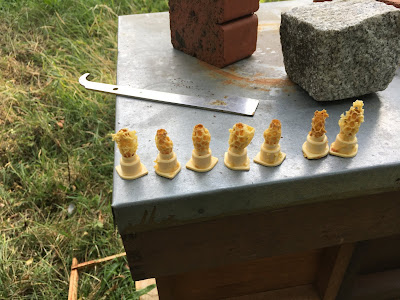 |
| Cheshire honey |
My main interest in beekeeping is queen breeding so honey production isn't high on my list of priorities. However, there wouldn't be much interest from other beekeepers in the bees that I breed if they weren't productive. Also the rearing of queens requires strong colonies, these by their very nature produce a surplus of the sticky stuff. It therefore is a fortunate/unfortunate fact that I have had to deal with this by product.
The process of honey removal, I found daunting. My apiaries are not ideal for honey production, they are not accessible by road, I have to carry or barrow supers over uneven ground. I can't do this alone and so have to rely on my not too enthusiastic sons for help.
Then follows the extraction process, what a job this is! I get the stuff everywhere, on the floor, on the work surfaces, up my arms and on my clothes. I currently use a simple two frame tangential extractor, cranked by hand. On one occasion I have almost taken someones head off using this, I was enthusiastically spinning the contraption when my hand slipped from the handle which flew off across the room at a considerable speed. Luckily it missed and no one was harmed.
So, having extracted and filtered this 'liquid gold', what was I to do with it? I could, and did, feed some back to nucleus colonies. Other than that, I was at a loss as to what to do. I bought some jars and gave a few away to family and friends. This was where I was really surprised, a few recipients of my honey disposal/give-away came back and asked for more, for themselves and others too! "It tastes so much better than the stuff we get from the supermarket" they told me. One chap from the allotment site asked "Have you got any of that bl**dy honey left? My wife keeps on at me to get some more".
It's strange but my dislike for the stuff has changed, I have a certain pride and satisfaction that my bees create this wonderful food that is so appreciated by others. I am careful to ensure that what I pass on to others is the best that I can produce, I don't want to undo all of the hard work that my bees have invested by presenting their honey in anything other than the best possible manner that I can. I use settling tanks after filtering so ensuring that fine pieces of wax are not introduced to the jars and that small bubbles settle in the tank, this way there is no foam or scum in the top of the jar. I use 3/4 lb hexagonal jars and attach a label proudly stating that the contents are Cheshire Honey.
I managed to acquire a honey warming cabinet this year. This has really enabled me to make huge steps forward in my presentation. I can now safely liquify crystallised honey. This lead to me thinking that I could, or should, expand my range by making some soft set honey. This has a longer shelf life in that it won't set hard after jarring and therefore won't need to be re-warmed before giving it away or selling it: Yes selling! I have found that there is a demand for this stuff and people are willing to pay for it, fancy that!
I researched soft set honey on the web and decided to follow the instructions given on the site The Apiarist. The process basically involves warming crystallised honey to 50°C over 24 to 36 hours when it will have fully melted to clear honey. It's best not to use honey that is very dark, this will give a muddy brown product that isn't very attractive. A seed stock (5% of the total weight) of soft set honey can be added and mixed into the batch of honey after filtering and allowing to cool to about 35°C. At this temperature the seed crystals will not dissolve and the mix will be mobile enough to thoroughly mix.
I bought some local soft set honey to use as an initial seed stock rather than grinding down crystallised honey in a pestle and mortar, much easier! I save three jars worth of each batch to use in subsequent batches.
I use a cordless drill to gently do the mixing, this saves a lot of effort too. The bucket of honey is then allowed to cool to below 12°C (easy in the colder months of the year) and stirred at 12 hour intervals. this produces soft set honey. Re-warming the bucket of honey to 35ºC to reduces the viscosity and enables it to be bottled relatively it easily, relatively!
Full and very clear instructions are available at the above link.
 |
| Soft set honey |







